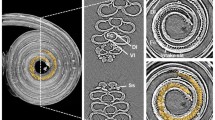Abstract
In this study, we investigated the dynamic functions of the tip region of the butterfly proboscis through which liquid is sucked during liquid feeding. The microstructures and flow patterns in the tip region of the proboscis were in vivo analyzed. The tip region can be divided into two functional sections: namely adhesion and suction sections. The liquid adheres to the adhesion section during liquid suction. Although the tip region has numerous slits connected to food canal of the proboscis, liquid is mainly sucked through the suction section, which section is submerged in the fluid pulled by the adhesion section and then successfully imbibes liquid. To check the dynamic functions of the tip region, we fabricated a suction tip model having adhesion and suction parts. The in vitro model experiments show that the hydrophilicity of the adhesion part and the existence of the suction inlet improve the liquid uptake driven by a suction pump. This study may provide insights for the biomimetic design of nectar-feeding butterflies.
Similar content being viewed by others
References
Laser D J, Santiago J G. A review of micropumps. Journal of Micromechanics and Microengineering, 2004, 14, R35–R64.
Yang H, Wu J, Yan S. Effects of erectable glossal hairs on a honeybee’s nectar-drinking strategy. Applied Physics Letters, 2014, 104, 263701.
Wu J, Yang H, Yan S. Energy saving strategies of honeybees in dipping nectar. Scientific Reports, 2015, 5, 15002.
Li C, Wu J, Yang Y, Zhu R, Yan S. Drag reduction in the mouthpart of a honeybee facilitated by galea ridges for nectar-dipping strategy. Journal of Bionic Engineering, 2015, 12, 70–78.
Li C, Wu J, Yang Y, Zhu R, Yan S. Drag reduction effects facilitated by microridges inside the mouthparts of honeybee workers and drones. Journal of Theoretical Biology, 2016, 389, 1–10.
Zhao Y, Wu J, Yang H, Yan S. The morphology and reciprocation movement of Honeybee’s hairy tongue for nectar uptake. Journal of Bionic Engineering, 2016, 13, 98–107.
Jaiswal S, Muthuswamy S. Instability analysis of mosquito fascicle under compressive load with vibrations and microneedle design. Journal of Bionic Engineering, 2015, 12, 443–452.
Kim W, Gilet T, Bush J W M. Optimal concentrations in nectar feeding. Proceedings of the National Academy of Sciences of the United States of America, 2011, 108, 16618–16621.
Kim W, Bush J W M. Natural drinking strategies. Journal of Fluid Mechanics, 2012, 705, 7–25.
Krenn H W. Feeding mechanisms of adult Lepidoptera: Structure, function, and evolution of the mouthparts. Annual Review of Entomology, 2010, 55, 307–327.
Eastham L E S, Eassa Y E E. The feeding mechanism of the butterfl? Pieris Brassicae L. Philosophical Transactions of the Royal Society B: Biological Sciences, 1955, 239, 1–43.
Eberhard S H, Krenn H W. Anatomy of the oral valve in nymphalid butterflies and a functional model for fluid uptake in Lepidoptera. Zoologischer Anzeiger-A Journal of Comparative Zoology, 2005, 243, 305–312.
Kingsolver J G, Daniel T L. Mechanics of food handling by fluid-feeding insects. In: Chapman R F, de Boer G, eds., Regulatory Mechanisms in Insect Feeding, Springer, New York, USA, 1995, 32–73.
Kingsolver J G, Daniel T L. On the mechanics and energetics of nectar feeding in butterflies. Journal of Theoretical Biology, 1979, 76, 167–179.
Daniel T L, Kingsolver J G, Meyhofer E. Mechanical determinants of nectar-feeding energetics in butterflies: Muscle mechanics, feeding geometry, and functional equivalence. Oecologia, 1989, 79, 66–75.
Pivnick K A, McNeil J N. Effects of nectar concentration on butterfly feeding: Measured feeding rates for Thymelicus lineola (Lepidoptera: Hesperiidae) and a general feeding model for adult Lepidoptera. Oecologia, 1985, 66, 226–237.
Borrell B J, Krenn H W. Nectar feeding in long-proboscis insects. In: Herrel A, Speck T, Rowe N P, eds., Ecology and Biomechanics: A Mechanical Approach to the Ecology of Animals and Plants, Taylor & Francis, Boca Raton, 2006, 185–212.
Boggs C L. Rates of nectar feeding in butterflies: Effects of sex, size, age and nectar concentration. Functional Ecology, 1988, 2, 289–295.
May P G. Nectar uptake rates and optimal nectar concentrations of two butterfly species. Oecologia, 1985, 66, 381–386.
Krenn H W, Plant J D, Szucsich N U. Mouthparts of flower-visiting insects. Arthropod Structure & Development, 2005, 34, 1–40.
Krenn H W. Functional morphology and movements of the proboscis of Lepidoptera (Insecta). Zoomorphology, 1990, 110, 105–114.
Krenn H W. Proboscis sensilla in Vanessa cardui (Nymphalidae, Lepidoptera): Functional morphology and significance in flower-probing. Zoomorphology, 1998, 118, 23–30.
Krenn H W, Kristensen N P. Early evolution of the proboscis of Lepidoptera (Insecta): External morphology of the galea in basal glossatan moths lineages, with remarks on the origin of the pilifers. Zoologischer Anzeiger, 2000, 239, 179–196.
Krenn H W, Zulka K P, Gatschnegg T. Proboscis morphology and food preferences in nymphalid butterflies (Lepidoptera: Nymphalidae). Journal of Zoology, 2001, 254, 17–26.
Lee S J, Lee S C, Kim B H. Liquid-intake flow around the tip of butterfly proboscis. Journal of Theoretical Biology, 2014, 348, 113–121.
Tsai C C, Monaenkova D, Beard C E, Adler P H, Kornev K G. Paradox of the drinking-straw model of the butterfly proboscis. Journal of Experimental Biology, 2014, 217, 2130–2138.
Adrian R J. Particle-imaging techniques for experimental fluid mechanics. Annual Review of Fluid Mechanics, 1991, 23, 261–304.
Lehnert M S, Monaenkova D, Andrukh T, Beard C E, Adler P H, Kornev K G. Hydrophobic-hydrophilic dichotomy of the butterfly proboscis. Journal of the Royal Society Interface, 2013, 10, 20130336.
Author information
Authors and Affiliations
Corresponding author
Rights and permissions
About this article
Cite this article
Lee, S.C., Kim, J.H. & Lee, S.J. Adhesion and Suction Functions of the Tip Region of a Nectar-drinking Butterfly Proboscis. J Bionic Eng 14, 600–606 (2017). https://doi.org/10.1016/S1672-6529(16)60425-0
Published:
Issue Date:
DOI: https://doi.org/10.1016/S1672-6529(16)60425-0




